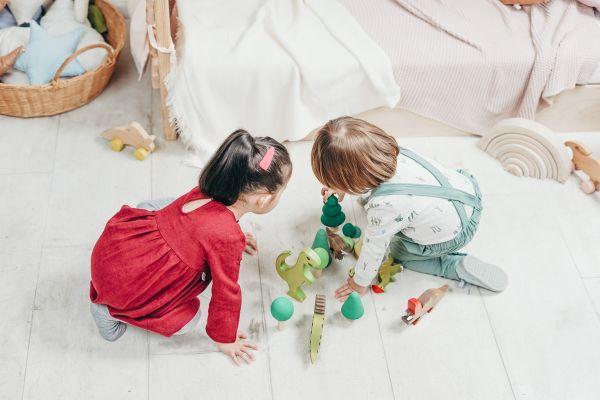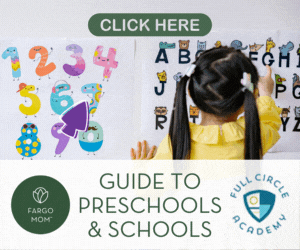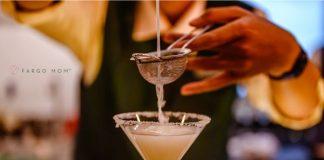
Mom confession: I’m not a huge fan of toys.
Some of my reasons are personal: We have a small house. I have a low clutter threshold. I don’t like the feeling of throwing or donating boxes of largely unused toys. And keeping up on the latest toy fads is exhausting.
But it’s actually my boys who are directing me to the path of toy minimalism (if only they knew)!
Play, Creativity, & the Concept of Loose Parts
Like many kids, my four-year-old can weave a pretty convincing story as to why he needs that totally amazing toy gleaming brilliantly from the shelf at Target and it will be his most beloved belonging forever.
Yet how often have I found that toy he “absolutely had to have” broken or cast off within a few days? Whether out of a desire to explore, or the toy just not meeting the true functional needs of his play (despite the well-played marketing), it leaves me wondering — are all these toys truly necessary?
When I started taking the time to observe my son in play, I saw overwhelmingly it was my child who made the magic happen, not the toy.
His favorite toys are often in attendance. But more often than not, his deepest, longest, and most exciting play happens with a culmination of loose parts — bits of this, pieces of that. Even my one-year-old will quickly bypass the cute “age-appropriate” toys and instead occupy himself with a pen for an impressive length of time.
I’ve discovered that the key to keeping my kids occupied and engaged longer in play isn’t more toys. In fact, the opposite seems to be true.
This doesn’t mean our house is devoid of toys. But this revelation has prompted more intentional gatekeeping of what enters (and stays) in our home. And it’s inspired me to get creative with what we already have.
Here are some ideas I’ve picked up along the way that may work for you!
Shop Your Home
My boys gravitate toward my husband’s tool chest, the kitchen utensil drawers, the bathroom cupboards, and containers of any kind during play (kids love using things from the adult world).
While it’s fascinating to see their creativity at work, the beating these items take in the process is not ideal.
Think of what your kids tend to run off with, or maybe haven’t been allowed to explore much for fear of damage. Lump those into themes, grab some clear plastic containers with lids (for your sanity), then “shop” your house!
Whatever you might have duplicates of, don’t use, or are destined for the recycle bin are fair game! (Or source items from a thrift store, garage sale, or giveaways from others).
Here are some ideas to get you started:
Themed Boxes of Loose Parts
Hardware Box
- Screwdrivers
- Bits of rope
- Magnets
- Small hammer
- Paintbrush
- Padlock with a key
- Clothes pins
- Various sizes of nuts, bolts, screws, washers (to minimize choking hazards for younger kids, use large sizes)
Wood Box
- Include wood scraps from projects, sticks and wood from around the yard, or popsicle sticks
- If you have the tools, spend some time creating a variety of shapes and sizes
- Sand them down to minimize splinters, and make sure none have toxic/harmful coatings or spills on them
Nature Box
Think “treasures” you might find on outdoor adventures. These may not become play things necessarily, but can provide opportunities for exploration, curiosity, and discussion.
- Feathers
- Pinecones
- Acorns
- Deceased bugs
- Cattails
- Animal bones
- Antlers
- Leaves
- Cool rocks
- Shells
Kitchen Box
For a fun twist — we store ours in a cute picnic basket along with our little collection of crochet play food!
- Spatula
- Butter knife
- Hand mixer
- Garlic press
- Mesh strainer
- Rolling pin
- Wooden spoon
- Jars
- Pizza cutter
Sewing Box
- Fabric — include a variety of sizes, shapes, textures, patterns, and colors
- Buttons
- Yarn and thread
- Big needles
- Zippers
- Velcro
Craft Box
- Various writing instruments
- Leftover bits and pieces from craft projects
- Variety of paper
- Kid scissors
- Glue or glue stick
- Stickers
- Newspaper
- Tape
- Beads, jewels, etc.
Recycle Bin Box
Clean these well and make sure there are no sharp edges.
- Milk jugs
- Boxes
- Aluminum cans
- Paper bags
- Plastic containers
These lists are by no means exhaustive — the sky is the limit! And remember, the beauty of loose parts is they are generally open-ended.
Keep ages in mind when pulling items together and don’t feel pressure to create all of these. Start with your child’s interests and what works for your home!
Open-Ended Toys
Toys are sometimes grouped into two categories: open-ended and close-ended.
A close-ended toy has a specific function. There is a pathway of play and, generally, a defined ending. Something is “achieved” (i.e. a puzzle or a board game).
Conversely, with open-ended toys, the child determines the function. There is no one “right” way to use the toy and they’re often basic in design.
One is not necessarily better than the other — it’s good to incorporate both, as each benefits children in different ways. But in my experience, for longevity of play, having a moderately higher ratio of open-ended toys has served us best.
Toys to Try
- Blocks
- Magna-tiles
- Art supplies
- Sensory mediums (sand, Play-dough, and kinetic sand)
- Building toys (Legos, DUPLOs, Tinkertoys, or Lincoln Logs)
- Bucket and shovel
- Wagon
- Play food
- Dolls
- Toy vehicles, trains, and train tracks
- Musical instruments
If possible, try to minimize flashiness. While sounds and lights may initially be attractive to your child, this can sometimes impede those deeper dives into make-believe.
Don’t Make All Toys Available All the Time
This is the most valuable suggestion I’ve come across. Sometimes too many options can be overwhelming, distracting, and make it hard for a child to settle into deeper play.
Create a Toy Library
In his book, Simplicity Parenting, author and educator Kim John Payne presents the idea of creating a “toy library.”
Start by downsizing to the most beloved or well-used toys. Then, keep a few options out for play and move the rest to a box (or closet or whatever makes sense to you — just somewhere out of sight). This will now be the “toy library.”
Here are a few guidelines that I use:
- For every toy that comes out of the library, one must go back in.
- Generally, I’ll let my son decide when he wants to do a toy swap. But to booster the sense of novelty, try to allow a couple of weeks between swaps.
- Every few months or so, I’ll do a comprehensive change out of toys to keep things fresh. This is also good time to re-evaluate what toys could be retired.
- I try to keep our toy library to one box. If, between our toy boxes and the toy library, there is not enough room to store all the toys we have, it’s time to downsize.
Play is the work of childhood.
As Fred Rogers said, “Play is often talked about as if it were a relief from serious learning. But for children play is serious learning. Play is really the work of childhood.”
It’s not our job as parents to keep our kids occupied. They are innately capable of creating play out of nothing and there is fruit in boredom.
By keeping an intentional environment and simply allowing the time and space, we can help them connect with what they were made to do: play. They’ll take care of the rest.
















